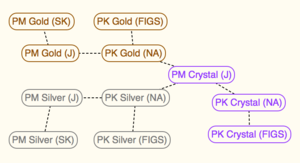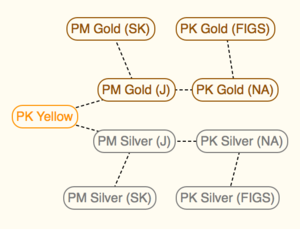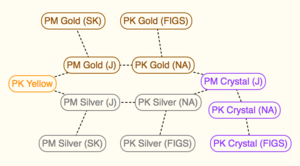Can we catch ‘em all?: Generation II
|
|
“How do we engage a work’s processes? Digital media are not simply representations but machines for generating representations.” – Noah Wardrip-Fruin, Expressive Processing: Digital Fictions, Computer Games, and Software Studies[1]
To say Pocket Monsters: Gold and Silver were heavily anticipated is a severe understatement. Development began in 1998, right after the original games were first released in Japan. Another year passed before their existence was revealed to the public at the 1999 Nintendo SpaceWorld Expo in Japan.[2] Here, Nintendo stated the games would not be another set of minor remakes. Instead, the games would be sequels to the originals with an entirely new plot, set of characters, and additions to the original 151 Pokémon. Generation II was intended to exist as an ending of the series. Satoru Iwata stated: "I didn’t intend to make any more Pokémon titles. I even thought that once we entered the twenty-first century, it would be time for me to do something else..."[3]
Executives at Game Freak and Nintendo both assumed these games would be the end of the Pokémon series. This assumption had many implications on the code structure of the games, a fact neither company discussed with the public for years to come.
Once again, it is helpful to look at Nintendo’s published descriptions of versions.
According to Nintendo, Generation II was released to Japanese audience in 1999 with Pocket Monsters: Gold and Silver.[4] They were marketed as the first core series optimized for Game Boy Color and advertisements heavily focused on the improved graphical aspects of the new system. However, the games were also accessible on any monochrome Game Boy system. As with the previous generation, the Japanese titles were translated into the near-identical Pokémon Gold and Silver for release in the United States[5] and Australia in 2000. European release followed in 2001 with translations in French, Italian, German, and Spanish.[6] For the first time, a Korean-language version titled Pocket Monsters: Gold and Silver was released in 2002.[7] Unlike all other version of the paired titles, this localization was only compatible with the Game Boy Color.
The first set of paired releases was followed in 2000 with the Japanese release of Pocket Monsters: Crystal Version.[8] This is the only core series Japanese game to contain the term Version in its title, an apt choice considering the significant number of new features relating to a new mobile network. However, the version was still marketed as a remake of the initial paired titles of the series and not as a stand-alone selection.[9]
Many of the new mobile features were removed for the localization of Pokémon Crystal Version, first released to the United States[10] in 2001 followed by Australia and finally Europe[11] in 2001. Unlike the first set of paired titles, for reasons unknown, no South Korean release followed. It is critical to note that all of these versions of Pocket Monsters: Crystal Version were compatible only with the Game Boy Color. This was the first Pokémon core series game to remove Game Boy compatibility entirely.
Consistently, throughout the advertisements, articles, and interviews, these titles are referred to as sequels. How are sequels defined? This question might appear obvious, but it is the heart of the mystery of Generation II.
In A Theory of Adaptation, Linda Hutcheon noted,“There is a difference between never wanting a story to end - the reason behind sequels…and wanting to retell the same story over and over in different ways.”[12] Considering such a definition, whether Generation II games function as sequels is unclear. On the one hand, Pocket Monsters: Gold and Silver do continue the story of Generation I with a return to Kanto. Facing Red as a final competition is a culmination of Generation I’s heroic quest. On the other hand, much of the narrative found in Generation II is simply the same story told in different ways, that of becoming a Pokémon Master.
Examining the code hidden within the games initially implies that Generation II is built upon, and therefore sequels of, Generation I. Unused maps such as a Safari Zone and Pokémon Lab on Cinnibar Island, as well as other unused tilesets, are almost completely intact from Generation I. The only difference is the addition of color. Smaller pieces of code also exist, such as unused text and Teru-sama, or dummy items.[13] However, none of these items are altered or adapted.
It is possible to narrow the point of origin to a specific game rather than the entirety of Generation I. Many in-game glitches were neutralized during the creation of Pocket Monsters: Pikachu and a handful were further removed from the international localization to Pokémon Yellow: Special Pikachu Edition. The lack of such glitches would suggest that the basis of Generation II titles is one of the many version of this final Generation I titles. Still, it is most likely that the North American version is the basis as it, like Generation II, was programmed for the Game Boy Color.[14]
To engage these games from a deeper media archaeological perspective, it is necessary to dig into the processes or mechanics of the games. This requires an examination of Pokémon data structures, the byte structure that contains all data regarding a Pokémon’s abilities and current status.[15] Metaphorically, the byte structure is the media archaeological explanation for a Pokémon’s personality and battle properties.
Variations between data structures of caught Pokémon in Generations I and II vary only minimally, but enough to cause monumental changes to processes. Each caught Pokémon utilizes one data structure when in the player’s party and another when in Bill’s PC. For this article’s purposes, only the former is necessary. In Generation I, a 44-byte data structure is utilized containing 33 “core bytes”.[16] This is increased to a 48-byte structure containing a decreased 32 “core bytes” in Generation I.[17]
Differences between data sets are best visualized when trading a Pokémon between the two generations via the Time Capsule feature. In total, ten value sets are rearranged during the trade process. Friendship, Pokérus, and caught data are all added to Pokémon traded from Generation I to II. Reversing the process removes the three values from the Pokémon. Interestingly, an additional seven values are recycled when shifting Pokémon from Generation I to II including , type, and catch rate.[12]
In addition to data structures, examining graphical alterations demonstrates that the official order of distribution was not synonymous with the order of localization. While suggestive as well as religious graphics from the Japanese Pocket Monsters: Gold and Silver were removed from most localizations, the South Korean version retains the original graphics.[18] This suggests that, while the Korean-language version was the last released, it was not the last produced. It has been suggested that difficulty implementing the Korean language is to blame for the delayed release, though no speculation can truly answer that question.
Therefore, the original assignment of the term sequel to these games becomes impossible from a media archaeological view. Unlike the official Nintendo diagram, the actual connections between versions of Pocket Monsters: Gold and Silver instead resemble the diagram to the right.
What can be understood from this mess? It can be argued that, rather than the sequels promoted by Nintendo, Generation II is best described as an adaptation of Generation I. Returning to Linda Hutcheon’s A Theory of Adaptation, three possible descriptions for adaptations are given: as a “transposition of a particular work,” “process of creation,” and “process of reception.”[12]
All three definitions give a better explanation to the nuances of the code provided by a media archaeological study. For Generation II, both transposition and reception focus on narrative rather than code. Generation I ended with the triumph of the player, Red, who reigns as Pokémon Master. Yet Generation II requires that the protagonist defeat Red, undermining the triumph of the first generation. This is especially crucial in terms of reception. Players that never encountered Generation I may have seen this scene as just another battle, but players familiar with the previous generation would have an entirely different emotional response.
It is the second definition of adaptation, the process of creation, that most refers to data uncovered by a media archaeological gaze. Hutcheon notes that this definition includes a process of appropriation. It would be a fair argument to call the reuse of Pokémon data structure bytes an appropriation of code. The same applies to reuse of maps, even if ultimately unused in the final product. It is the nature of video games to recycle and adapt rather than invent from scratch, but in the case of Pocket Monsters: Gold and Silver, these adaptations significantly demonstrate that Nintendo’s official announcements regarding the linear place of these games is not infallible.
Having solved the initial mystery, a more complicated one remains: how does Pocket Monsters: Crystal Version fit into all of this? In Generation I, Pocket Monsters: Yellow was rightfully considered a version of the original paired releases as it merely contained graphical enhancements and select changes to the narrative.[19] Differences to Pocket Monsters: Crystal Version are more substantial, perhaps even worthy of the term adaptation. But what, if anything, does this game adapt and how can a media archaeological focus uncover those details? Of all the changes, it is three sets of changes that answer this question: change of platform, addition of Pokémon Mobile Center GB, and the Battle Tower.
Many graphical alterations to Pocket Monsters: Crystal Version were only possible due to the change in platform. Why Nintendo or Game Freak shifted this latest Generation II release exclusively to the Game Boy Color is unknown. What is known is that many of the celebrated features of the game owe a debt to that platform upgrade. For example, the inclusion of animated Pokémon sprites was possible on a Game Boy, but the nuances of movement brought forward by creative use of color were only possible with color graphics. It would have been possible to utilize animated sprites before, but the effect would have been muted. Similarly, the difference between male and female protagonists takes on an entirely new dimension when their similar body shapes are differentiated by color.[20] In these cases, media archaeology demonstrates that the shift to Game Boy Color aided the creative decisions of the game’s programmers, possibly influencing such a decision.
The inclusion of the Battle Tower is another curious question regarding adaptations. Fights within this space are similar to those found in the console-exclusive Pokémon Stadium.[21] It could be argued that portions of Pocket Monsters: Crystal Version, then, were not only adaptations of Generation I but also adaptations of mechanics outside the core series franchise. If true, it would be the first of the core series games to utilize mechanics outside that core.
Of the three major alterations, what is most intriguing is the Pokémon Mobile System GB. Japanese editions of the game were bundled with a Mobile Adapter GB allowing access to other players through mobile phone networks. The list of associated features is extensive and has been discussed at length elsewhere. When localized for the rest of the world, Pokémon Crystal Version did not include many of these features, while others were altered for access without the Mobile Adapter GB. Several online sites, including Bulbapedia, state that Nintendo’s official reason is because the Federal Communications Commission (FCC) did not allow the Mobile Adapter GB to enter the United States.[22] As a result, none of the associated features were included. Still, there are no sources to verify that this story even took place.
Media archaeology gives an interesting twist to this story. Breaking into the code indicates that the Pokémon Mobile System GB and Mobile Stadium were completely included in international localizations, though ultimately unused. The translations are partially complete with the most progress made to English-language versions followed by German and Spanish, with little to no translation in French and Italian versions.
The inclusion of these unused areas, along with a substantial amount of translation, indicates that the decision to remove mobile elements was not an early one. Instead, the decision was made late and abruptly in the localization process, considering the level of translations already in place. Of course, media archaeology cannot tell us why this decision happened, but it can tell us that the situation surrounding this executive decision was sudden and possibly unexpected.
Combining all of this information, the diagram of Generation II versions now appears to be something like the image to the right.
It can be argued that Pocket Monsters: Crystal Version is not simply another version of Generation II. It is an adaptation of Pocket Monsters: Gold and Silver with the inclusion of adapted elements from Pokémon Stadium. In addition, Pokémon Crystal Version and its international localizations are not mere translations but instead adaptations of the Japanese version, compensating for the loss created by the sudden removal of the Mobile Adapter GB.
There is no single method of media studies that can solve all the questions that players might have. Using media archaeology and adaptation theory solves many of the questions within Generation II, but they cannot solve all of them. Answering every question, however, is not the point. The point is to gain as full an understanding of this strange generation as possible, to understand its intricacies a little better, and to perhaps even appreciate the effort it takes to create such a complicated network of versions.
| Can we catch ‘em all? |
|---|
| By ArchivistGeek |
| Introduction |
References
- ↑ Noah Wardrip-Fruin,Expressive Processing: Digital Fictions, Computer Games, and Software Studies (Cambridge: MIT Press, 2009).
- ↑ http://www.ign.com/articles/1999/08/28/eye-on-pokemon-gold-and-silver
- ↑ http://www.nintendo.co.uk/Iwata-Asks/Iwata-Asks-Pokemon-HeartGold-Version-SoulSilver-Version/Iwata-Asks-Pokemon-HeartGold-Version-SoulSilver-Version/2-The-King-Of-Portable-Toys/2-
- ↑ http://www.pokemon.co.jp/game/other/gbc-gs/
- ↑ http://www.pokemon.com/us/pokemon-video-games/pokemon-gold-version-and-pokemon-silver-version/
- ↑ http://www.pokemon.com/uk/pokemon-video-games/pokemon-gold-version-and-pokemon-silver-version/
- ↑ http://moviepilot.com/posts/2014/09/25/the-koreanization-of-pokemon-or-simply-pokemon-in-south-korea-2296686?lt_source=external,manual
- ↑ http://www.pokemon.co.jp/game/other/gbc-crystal/
- ↑ http://spong.com/press_release/1660/Nintendo-Unveils-New-Jewel-with-Pokemon-Crystal
- ↑ http://www.pokemon.com/us/pokemon-video-games/pokemon-crystal-version/
- ↑ http://www.pokemon.com/uk/pokemon-video-games/pokemon-crystal-version/
- ↑ 12.0 12.1 12.2 Linda Hutcheon, A Theory of Adaptation, 2nd ed. (New York: Routledge, 2013)
- ↑ http://tcrf.net/Pokémon_Gold_and_Silver
- ↑ http://tcrf.net/Pokémon_Yellow
- ↑ http://www.smogon.com/smog/issue27/glitch
- ↑ http://bulbapedia.bulbagarden.net/wiki/Pokémon_data_structure_in_Generation_I
- ↑ http://bulbapedia.bulbagarden.net/wiki/Pokémon_data_structure_in_Generation_II
- ↑ http://iimarck.us/i/changed-designs/
- ↑ http://tcrf.net/Pokémon_Yellow
- ↑ http://www.ign.com/articles/2000/12/12/pokemon-crystal
- ↑ http://www.ign.com/articles/2001/07/30/pokemon-crystal-2
- ↑ http://bulbapedia.bulbagarden.net/wiki/Pokémon_Crystal_Version#cite_note-2


